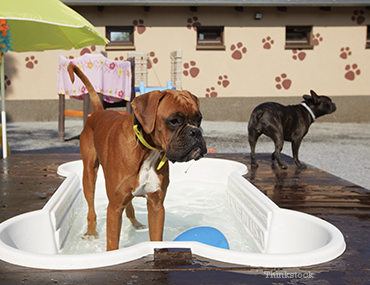
Cryptosporidium: it’s a parasite you have never seen and likely never heard of. But, with so much spring-time emphasis on the prevention and control of internal and external parasites, it is important that you understand this parasite’s impact on dogs and cats.
What is Cryptosporidium?
Cryptosporidium is a microscopic protozoon parasite that causes acute, chronic or intermittent diarrhea in infected animals and people, a condition called cryptosporidiosis. Infected animals may not show any clinical signs but are still a source of environmental contamination. It can be difficult to detect Cryptosporidium eggs in the feces by microscope because they are very small. Other diagnostic tests include immunologic tests such as IFA, ELISA or latex agglutination. Polymerase chain reaction, PCR, is now routinely available and has helped make diagnosis easier. Surveys have shown that infection is quite common in dogs and cats. According to the CDC, Cryptosporidium is also one of the most frequent causes of waterborne disease among humans in the United States.
 Cryptosporidium in people
Cryptosporidium in people
Most human infections of Cryptosporidium are caused by contaminated food and water, according to the CDC’s website; however, it can be spread from animal to human. The infection “usually causes a mild to severe infection of the gastrointestinal system, including watery diarrhea, fever, abdominal cramps, nausea, and vomiting,” says the CDC’s page.
Cryptosporidium infection is of particular concern in humans that are immuno-compromised.
There are several species that infect animals and may infect people; C. canis infects dogs while C. felis infects cats. While both species have rarely been associated with human infections, those people who are infected by these strains are usually immune-compromised. Calves are more commonly infected by these strains, which often travel with state fairs. Humans are most commonly infected by C. parvum or C. hominis. For tips on how to avoid infection in people visit the CDC’s website.
How do people, dogs, or cats get cryptosporidiosis?
Infection of animals and people alike occurs as a result of swallowing infective oocysts, primarily in contaminated drinking water or recreational water such as swimming pools and water parks. The parasite is protected by an outer shell that allows it to survive outside the body for long periods of time and makes it very tolerant to chlorine disinfection.
The best means of prevention is elimination of exposure to potentially contaminated water supplies.
How can cryptosporidiosis be treated?
Most cases are mild and resolve without specific treatment. Several drugs are available for serious infections but none are consistently effective. Adding fiber to the diet or giving a probiotic may be helpful in some patients.
If you have any questions or concerns, you should always visit or call your veterinarian -- they are your best resource to ensure the health and well-being of your pets.

